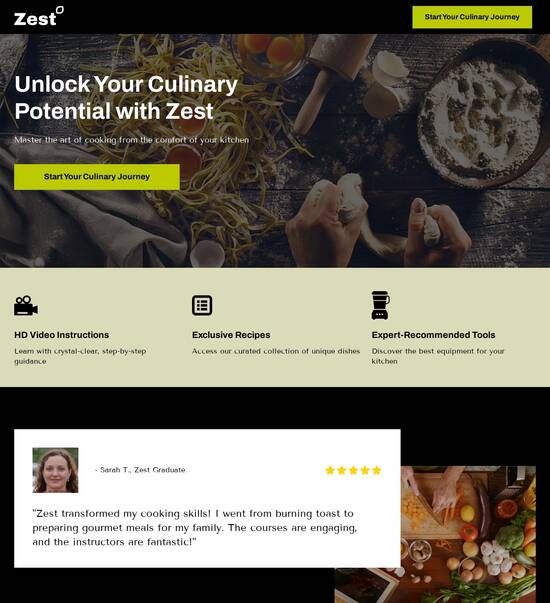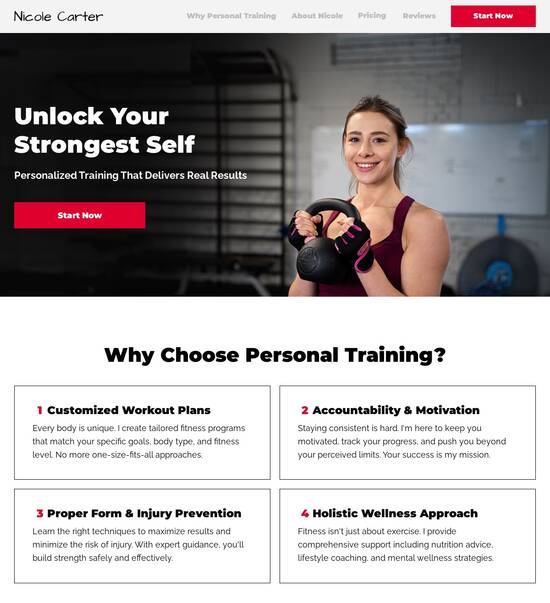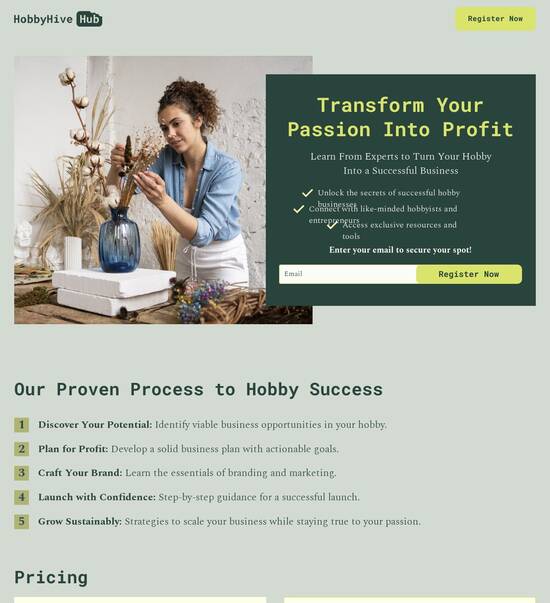
React.js optimized product details page template
Explore Similar TemplatesAbout template
Supercharge your product details page with React.js for outstanding performance! Learn more today.
Recommended templates

Easy to build without coding
With the intuitive drag-and-drop builder, anyone on your team can create high-converting pages without any knowledge of code or design. Make enhancements to your landing page with custom widgets using Javascript, HTML/CSS, or third-party scripts.

Multiple layouts for any industry and goal
Select from 500+ landing page layouts built to boost conversions across industry-specific scenarios. Customize them by adjusting fonts, adding images, and generating on-brand content with the AI assistant. Quickly scale with Instablocks® and Global Blocks that you can save, reuse, and update globally.

Loads fast and looks polished on any device
Every template is responsive, which means they present professionally on any device and load blazingly fast with our Thor Render Engine. You can also power them up with Google AMP technology to deliver an unparalleled mobile experience and drive higher conversions.

Robust analytics & experimentation
Get real-time updates and reporting across all your devices, showing the number of visitors, conversions, cost-per-visitor, and cost-per-lead. Launch AI-powered experiments, run A/B tests, and use heatmaps to analyze user behavior, then optimize your landing page to maximize conversions.







Easy to build without coding
With the intuitive drag-and-drop builder, anyone on your team can create high-converting pages without any knowledge of code or design. Make enhancements to your landing page with custom widgets using Javascript, HTML/CSS, or third-party scripts.
Multiple layouts for any industry and goal
Select from 500+ landing page layouts built to boost conversions across industry-specific scenarios. Customize them by adjusting fonts, adding images, and generating on-brand content with the AI assistant. Quickly scale with Instablocks® and Global Blocks that you can save, reuse, and update globally.
Loads fast and looks polished on any device
Every template is responsive, which means they present professionally on any device and load blazingly fast with our Thor Render Engine.
Robust analytics & experimentation
Get real-time updates and reporting across all your devices, showing the number of visitors, conversions, cost-per-visitor, and cost-per-lead. Launch AI-powered experiments, run A/B tests, and use heatmaps to analyze user behavior, then optimize your landing page to maximize conversions.
All the features you need to build react product detail page template
Explore more featuresLearn how to build product detail page in react js
FAQs
Leading the way in building high-performing landing pages





A powerful landing page solution with Instapage
Streamlining your marketing campaigns is essential to maximizing your return on investment (ROI). Instapage stands out as a premier landing page and conversion rate optimization (CRO) platform, designed to aid marketers in accelerating and optimizing their digital marketing efforts effectively. This comprehensive guide will walk you through the features that make Instapage the go-to choice for businesses in sectors ranging from marketing and advertising to technology and education, ensuring you extract the most value from your campaigns.
Understanding the features of Instapage
Instapage offers a versatile platform tailored for marketers who desire flexibility and ease of use. With over 100 professional templates and pre-built lead generation elements, users can quickly set up effective landing pages without needing extensive technical knowledge. This section delves into the standout features available on Instapage that contribute to higher conversions:
- Templates: Choose from 100+ high-converting templates that are pre-optimized for various industries, ensuring a speedy setup.
- Landing Page Builder: Utilize a user-friendly, drag-and-drop interface that allows quick adjustments, perfect for marketers needing to launch pages rapidly.
- Experiments: Enhance page performance with comprehensive A/B testing capabilities and detailed analytics to track visitor interaction.
First steps to creating your landing page
Getting started with Instapage is straightforward. Follow these simple steps to create your first effective landing page:
- Choose a template that fits your campaign goals, whether promoting a product or generating leads.
- Customize the chosen template using the drag-and-drop builder to align with your brand and messaging.
- Integrate lead generation forms and CTA buttons strategically placed to capture visitor information effectively.
Optimizing your landing page for better performance
After launching your landing page, continuous optimization is vital. Here’s how to ensure your landing page remains effective:
- Conduct regular A/B testing to analyse which elements perform better and refine your strategy accordingly.
- Utilize heatmaps to understand user behavior and adjust your design to enhance the user experience.
- Monitor analytics data to measure conversions and identify areas needing improvement.
By following these steps, marketers can utilize Instapage to create landing pages that not only attract but convert visitors into engaged customers.
In conclusion, Instapage is not just another landing page builder; it’s a powerful tool that equips marketers with the essential elements for success. The integration of powerful analytics, user-friendly features, and collaboration tools makes it the ideal choice for businesses across various sectors.
Ready to elevate your marketing game? Sign up for Instapage today and unlock the full potential of your digital campaigns!
People also ask about React.js optimized product details page template
Unlocking the potential of a React.js optimized product details page template
The importance of a product details page in e-commerce
In the realm of e-commerce, the product details page (PDP) is critical as it serves as the centerpiece of customer decision-making. An informative and engaging PDP can significantly influence purchasing decisions, encouraging visitors to convert into customers. When effectively crafted, the PDP not only showcases the product, but it also answers potential questions, addresses concerns, and builds loyalty. Customers often look for detailed and compelling product descriptions, specifications, and images before committing to a purchase.
An optimized product details page enhances conversion rates through improved design and strategic content placement. Research suggests that well-structured information directly correlates with increased sales; when users can quickly find what they are looking for, their likelihood of completing a transaction rises dramatically. Furthermore, an effective PDP creates a seamless user experience, instilling confidence and satisfaction, which can lead to repeat visits and future purchases.
Diving into React.js: A robust framework for building dynamic interfaces
React.js, a JavaScript library developed by Facebook, is renowned for its component-based architecture, enabling developers to build user interfaces with ease and efficiency. Its unique feature of a virtual DOM allows for faster UI updates, increasing application performance—a critical aspect of any e-commerce platform. With React, developers can create reusable components that can be easily integrated into product details pages, ensuring consistency while minimizing repetitive coding efforts.
Using React.js for product details pages offers significant advantages, such as real-time updates and interactive elements. This capability is essential for providing users with instant feedback, such as adding items to a cart or updating quantities, without requiring full-page refreshes. Additionally, as businesses scale, the ease of maintenance and adaptability of React.js means developers can implement changes quickly, which is vital in an ever-evolving marketplace.
Key features of a React.js optimized product details page template
A React.js optimized product details page template should integrate several key features to maximize performance and user experience. First and foremost is responsive and adaptive design, which ensures the template performs well on any device. Implementing mobile-first design principles is paramount, given the increasing number of consumers shopping via smartphones and tablets. Scalability across devices and screen sizes not only enhances accessibility but also helps in retaining customer interest and engagement.
Next, dynamic content rendering plays a crucial role in managing product information efficiently. React’s state and props provide mechanisms to display real-time updates of product details. Another important aspect is server-side rendering (SSR), which can boost SEO rankings by enabling search engines to index product pages effectively. Finally, rich media integration is essential for showcasing products in detail. Strategies like including high-resolution images, videos, and 360-degree views enrich the user experience, allowing customers to visualize the product as if they were looking at it in a physical store.
Essential functionalities for enhanced user experience
To further improve user experience on product details pages, incorporating interactive product visualizations can be highly beneficial. Tools such as sliders and toggles allow users to engage with product features, increasing their likelihood of conversion. By providing interactive elements, customers can visualize different styles and colors, helping them make informed decisions without having to leave the page.
User reviews and ratings systems also serve to create community-driven content that fosters social proof. By showcasing user-generated content effectively, businesses can enhance credibility, which is often a deciding factor for new customers. Furthermore, implementing live Q&A features ensures that customers can receive rapid responses to their queries, significantly enhancing trust and customer satisfaction. Being able to communicate easily with a brand proves vital, especially when making purchasing decisions.
Technologies and tools to optimize your product page
API integrations are essential for dynamic data fetching and updating product information in real time. By connecting with external sources, such as inventory databases or shipping APIs, e-commerce businesses can keep product information current, eliminating discrepancies that may frustrate customers. Popular services like RESTful APIs and GraphQL can be utilized effectively to pull and push necessary data on product details pages, ensuring users receive the most accurate information.
Additionally, SEO best practices should be employed to optimize product titles, descriptions, and metadata. Implementing schema markup can significantly enhance search visibility by helping search engines understand the layout and content of product pages better. Moreover, analyzing performance metrics through dedicated React tools is crucial. Regular profiling and monitoring load times allow developers to optimize content and improve user retention.
Engaging communities and collectives for knowledge sharing
Participating in online forums and platforms tailored for developers is vital for discussing challenges and solutions in building product pages. Websites such as Stack Overflow, Reddit, and specialized e-commerce development communities offer excellent resources for knowledge exchange. Here, developers can share templates, codes, and troubleshooting methods, creating a culture of support that improves the quality of product details pages across the board.
Furthermore, contributions from open-source projects play an integral role in enhancing React knowledge. By leveraging collective insights and solutions, developers can accelerate their learning curve, resulting in more innovative and efficient product page designs. Embracing open-source resources leads to shared expertise that benefits the wider e-commerce developer community.
Employing teams to enhance the development process
Creating a collaborative workflow is fundamental to building optimized product pages. Clearly defined roles and responsibilities within a development team ensure that every aspect, from coding to design and testing, is addressed effectively. Agile methodologies can enhance productivity and flexibility, enabling teams to respond quickly to changing requirements or user feedback.
Equally important is the collaboration between cross-disciplinary teams, including UX/UI designers, developers, and marketers. By drawing on diverse skill sets, teams can produce innovative solutions that maximize the potential of product details pages. This integrated approach allows for a cohesive strategy in presenting product information that aligns with both user expectations and business objectives.
Strategies for continuous optimization
Continuous optimization is key to maintaining effective product pages. Techniques such as A/B testing different layouts and functionalities can provide invaluable insights into user interactions. By designing experiments that test variations, businesses can gather data to drive iterative improvements on product details pages, making them increasingly efficient and user-friendly.
Collecting user feedback is another important strategy for ongoing improvement. Implementing methods for effectively gathering customer insights through surveys, focus groups, or even observation techniques helps illustrate user needs and expectations. This feedback has a considerable impact on shaping product page features, allowing businesses to tailor their designs and content to better serve their audiences.
Scalability and customization options
When building a product details page template with React.js, scalability and customization are critical considerations. A well-structured template should be adaptable for various product types, allowing different businesses to leverage the same foundational design while tailoring specific elements to their needs. This flexibility not only saves development time but also affords brands the opportunity to maintain their identity and unique offerings.
Moreover, strategies for scaling the application as the business grows are vital. As product offerings expand, the ability to add new features or functionality seamlessly is crucial to sustaining long-term success. By focusing on modular coding practices and leveraging React’s component-based framework, developers can ensure that as the business scales, the product page can evolve without substantial overhauls.
Real-world examples of successful implementations
Examining case studies of e-commerce brands that utilize React.js for their product pages reveals valuable insights. Many successful brands have experienced enhanced performance metrics, such as increased conversion rates and reduced bounce rates after optimizing their product details pages. These implementations often showcase the effectiveness of combining rich media with interactive elements, ultimately providing users with a more immersive shopping experience.
Key takeaways from these examples include the importance of continuous testing and improvement, as companies that actively refine their product pages based on real user data tend to see better results. Moreover, the use of React.js's unique features enables these brands to stay ahead of competitors by providing a seamless and engaging customer experience, proving that the right tools can make a significant impact on e-commerce success.
Ready to skyrocket conversions?
Supercharge your ad campaigns with high-performing landing pages
Get started














